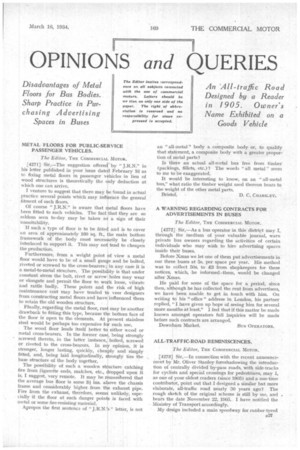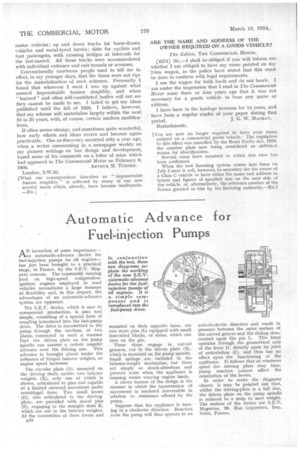OPINIONS and QUERIES
Page 37

Page 38

If you've noticed an error in this article please click here to report it so we can fix it.
Disadvantages of Metal Floors for Bus Bodies. Sharp Practice in Purchasing Advertising Spaces in Buses
An -All-traffic Road Designed by a Reader in 1905. Owner's Name Exhibited on a
Goods Vehicle
METAL FLOORS FOR PUBLIC-SERVICE PASSENGER VEHICLES.
The Editor, THE COMMERCIAL MOTOR.
[4271] Sir,—The suggestion offered by " in his letter published in your issue dated February 16 as to fixing metal floors in passenger vehicles in lieu of wood structures is theoretically the only deduction at which one can arrive.
I venture to suggest that there may be found in actual practice several points which may influence the general fitment of such floors.
Of course " J.R,N." is aware that metal floors have been fitted to such vehicles. The fact that they are so seldom seen to-day may be taken as a sign of their unsuitability.
If such a type of floor is to be fitted and is to cover an area of approximately 160 sq. ft., the main bottom framework of the body must necessarily be closely interlaced to support it. This may not tend to cheapen the production.
Furthermore, from a weight point of view a metal floor would have to be of a small gauge and be bolted, riveted or screwed to the cross-bearers ; in any case it is a metal-to-metal structure. The possibility is that under constant stress the bolt, rivet or screw holes may wear or elongate and permit the floor to work loose, vibrate and rattle badly. These points and the risk of high maintenance cost may have tended to veer designers from constructing metal floors and have influenced them to retain the old wooden structure.
Finally, regarding the metal floor, rust may be another drawback to fitting this type, because the bottom face of the floor is open to the elements. At present stainless steel would be perhaps too expensive for such use.
The wood floor lends itself better to either vi cod or metal cross-bearers. In the former case, being strongly screwed thereto, in the latter instance, bolted, screwed or riveted to the cross-bearers. In my opinion, it is stronger, longer lasting, quickly, cheaply and simply fitted, and, being laid longitudinally, strongly ties the base structure of the body together.
The possibility of such a wooden structure catching fire from Cigarette ends, matches, etc., dropped upon it is, I suggest, very remote. It may be remembered that the average bus floor is some 34 ins, above the chassis frame and considerably higher. from the exhaust pipe. Fire from the exhaust, therefore, seems unlikely, espedaily if the floor at such danger points is faced with metal or some fire-resisting material.
Apropos the first sentence of " J. " letter, is not an " all-metal " body a composite body or, to qualify that statement, a composite body with a greater proportion of metal parts?
Is there an actual all-metal bus free from timber (packings, fillets, etc.)? The words "all metal seem to me to be exaggerated.
It would be interesting to know, on an " bus," what ratio the timber weight used thereon bears to the weight of the other metal parts.
Bristol. D. C. CHARSLEY.
A WARNING REGARDING CONTRACTS FOR ADVERTISEMENTS IN BUSES
The Editor, THE COMMERCIAL MOTOR.
[4272] Sir,—As a bus operator in this district may I, through the medium of your valuable journal, warn private bus owners regarding the activities of certain individuals who may wish to hire advertising spaces inside their buses.
Before Xmas we let one of them put advertisements in our three buses at 5s. per space per year. His method was to collect 50s. to 0 from shopkeepers for these notices, which, he informed .them, would be changed after Xmas.
He paid for some of the space for a period, since then, although he has collected the rent from advertisers, we have been unable to get in touch with him. On writing to his " office " address in London, his partner replied, "I have given up hope of seeing him for several more months at least." I feel that if this matter be made known amongst operators full inquiries will be made before such contracts are arranged.
Downham Market, Bus OPERATORS,
ALL-TRAFFIC-ROAD REMINISCENCES. The Editor, THE COMMERCIAL MOTOR.
[4273] Sir,—In connection with the recent announcement by Mr. Oliver Stanley foreshadowing the introduction of centrally divided by-pass roads, with side-tracks for cyclists and special crossings for pedestrians, may I, as one of your oldest readers (since 1905) and a one-time contributor, point out that I designed a similar but more elaborate, all-traffic road nearly 30 years ago? The rough sketch of the original scheme is still by me, and . bears the date November 22, 1905. I have notified the Ministry of Transport accordingly.
My design included a main speedway for rubber-tyred motor vehicles ; up and down tracks for horse-drawn vehicles and metal-tyrecl lorries ; ditto for cyclists and foot passengers, with crossing bridges at intervals for the last-named. All these tracks were accommodated with individual entrance and exit tunnels or avenues.
Conventionally courteous people used to tell me in effect, in my younger days, that the times were not ripe for the materialization of such schemes. Personally I found that wherever I went I was up against what seemed impenetrable human stupidity, and when " learned " and often self-constituted bodies will not see they cannot be made to see. I failed to get iny ideas published until the fall of 1928. I believe, however, that my scheme will materialize largely within the next 10 to 20 years, with, of course, certain modern modifications.
It often seems strange, and sometimes quite wonderful, how early efforts and ideas revive and become again practicable. One re-discovery occurred only a year ago, when a writer commenting in a newspaper weekly on my pioneer writings on bus design and development, based some of his comments on a letter of mine which had appeared in The Commercial Motor on February 8, 390G. ARTHUR M. TURNER. London, S.W.20.
[What our correspondent describes as " impenetrable human stupidity " is reflected by many of our new . arterial roads which, already, have become inadequate.
—En.]
ARE THE NAME AND ADDRESS OF THE OWNER REQUIRED ON A GOODS VEHICLE?
The Editor, THE COMMERCIAL MOTOR.
[4274] Sir,—I shall be obliged if you will inform me whether I am obliged to have my name painted on my 2-ton wagon, as the police have stated that this must be done to conform with legal requirements.
I use the wagon for bulk loads and do not hawk. I am under the impression that I read in The Commercial Motor some three or four years ago that it was not necessary for a goods vehicle to bear any name or address.
I have been in the have been a regular period.
Butterknowle.
haulage business for 14 years, and reader of your paper during that J. G. W. MAcxAy.
[You are now no longer required to have your name painted on a commercial goods vehicle. The regulation to this effect was cancelled by the Road Traffic Act. 1930. the number plate now being considered as sufficient means for identification.
Several cases have occurred in which this view has been confirmed.
When the new licensing system comes into force on July 1 next it will, however, be necessary for the owner of a Class C vehicle to have either his name and address in letters and figures of specified size on the near side of the vehicle, or, alternatively, the reference number of the licence granted to him by the licensing authority.—En.1




















































































